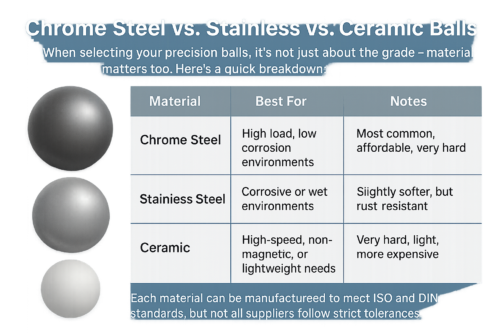What Does “Grade” Really Mean for Bearing Balls?
When sourcing precision balls for bearings, motors, or high-speed machinery, the ball grade is one of the most important factors to consider.
The grade refers to a classification system that defines the precision, roundness, and surface quality of the ball. Simply put: the lower the grade number, the higher the quality and precision.
Bearing Ball Grades at a Glance
Here’s a quick breakdown of what grade means in practical terms:
| Grade Number | Precision Level | Typical Use |
|---|---|---|
| Grade 5 | Ultra-precision | Aerospace, surgical tools, high-speed applications |
| Grade 10 | High-precision | Robotics, lab equipment, automotive sensors |
| Grade 25 | General use | Electric motors, bicycles, pumps |
| Grade 100+ | Low precision | Low-load applications, casual motion assemblies |
How Is a Grade Determined?
Each grade is assigned based on how closely the ball’s diameter and surface meet precise tolerances. For example:
- Grade 25: Maximum deviation in diameter is 0.000025 inches (or 0.000635 mm)
- Grade 10: Even tighter tolerance — only 10 millionths of an inch
- Grade 5: Precision at just 5 millionths of an inch, with an ultra-smooth surface
The smoother the ball and the closer it is to a perfect sphere, the less friction and the more efficiency you’ll get in your final product.
Why Surface Finish Matters
A bearing ball’s surface finish affects:
- 🛞 Rolling performance
- 🔧 Heat generation and friction
- 🧭 Longevity of the bearing
- 🤖 Noise and vibration in high-speed systems
Higher-grade balls (e.g., Grade 5 or 10) are polished to eliminate microscopic imperfections — something that’s essential in aerospace, medical, or high-precision automation systems.
Choosing the Right Grade for Your Application
Some examples of typical grade usage:
- Grade 5: High-speed turbines, aerospace instrumentation, surgical robots
- Grade 10: CNC spindles, automotive sensors, high-end motors
- Grade 25: General-purpose ball bearings, electric tools, hobby applications
- Grade 100+: Low-speed or low-load environments where ultra-precision isn’t required
If you’re unsure, we recommend talking to a supplier like STR Industries which can help you match grade + material to your tolerance needs, load specs, and environmental conditions.
Grade vs. Material: Know the Difference
The grade of a bearing ball refers specifically to how precisely it’s manufactured — not what it’s made from.
You can have:
- Grade 10 chrome steel balls
- Grade 25 stainless steel balls
- Grade 5 ceramic balls
Each material impacts performance in different ways (corrosion resistance, strength, temperature handling), but the grade affects accuracy and smoothness.
The Bottom Line
As machine speeds increase and tolerances get tighter, understanding bearing ball grades becomes even more essential. If you’re building for longevity, efficiency, or safety — selecting the right grade is a non-negotiable.
🔍 Need Help Sourcing the Right Grade?
At STR Industries, we carry a wide range of bearing ball grades in multiple materials, and we can help you select the right grade for your application, industry, and budget.
👉 Contact our team to get a custom quote or discuss a project.


